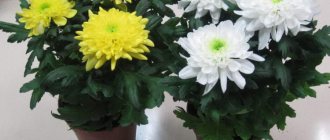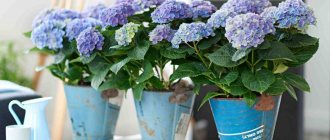The rose is considered the queen of all flowers. It is grown in open ground, greenhouses and even at home. Bengal, polyanthus and remontant varieties are usually chosen as indoor plants. However, some flower growers also keep roses grown from a donated bouquet in their apartment. Such plants delight the owner with long-term flowering for many years.
Indoor roses are capricious and demanding to care for. In order for them to develop properly, not get sick and bloom profusely, it is important to give them enough attention and provide optimal living conditions. We'll tell you how to care for a homemade rose in a pot in this article.
How to choose a flower in a store
Firstly, the basis of the correct choice of any indoor plant is its appearance . If an ornamental rose is sold in a pot (temporary or permanent), then it is important to inspect its leaves and shoots.
Indoor rose in store pots
Black dots on the back or outside are a sign of fungal diseases. Small white spots may be a sign of active development of powdery mildew. If dark or dry spots are noticed closer to the root collar, then this is one of the signs of putrefactive or fungal processes in the soil and on the roots.
It is BEST when the rose has dense leaves with a clear shine. Also a good sign of a healthy indoor plant is the presence of young shoots. Then you can be sure that the flower was well looked after and the conditions for it were ideal.
Finally, the rule is that it is preferable to purchase an indoor rose with fewer buds. The more flowers there are on a plant, the faster it will bloom, and the next period of budding will have to wait until the next season.
Well, yellowed, drooping leaves are a sure sign that the indoor rose lacks moisture and nutrients. You can make up for this yourself at home, but a rose in a pot will take time to get into shape.
Care after purchase
From the moment they purchase a flower, many buyers think about how to preserve and enhance the beauty of the capricious beauty at home. Here you need a whole range of measures to care for a mini-rose growing in a pot, which should be carried out strictly to obtain the desired result after purchase:
- As soon as the plant gets into the house, you need to immediately empty the pot from its special packaging, most often a plastic film that creates a humid atmosphere inside the bag. If left, the plant may become affected by mold and die.
- All dry leaves and stems must be carefully cut off with a sharp knife. Sections can be treated with powdered activated carbon. Inspect the soil at the roots and remove fallen leaves to prevent them from becoming a source of infection.
- Next, the rose must be given the opportunity to adapt to the conditions of its new home.
- After 10 days, you can begin to transplant the plant into a permanent container. During the quarantine period, all possible diseases and pests will have time to manifest themselves.
- An important point: replanting should not be carried out during the period of rapid flowering; it is better to wait until most of the buds open and bloom. Then you can carefully, without disturbing the integrity of the roots and the earth, transplant the flower into a new, more spacious container. An indoor rose can live in an apartment with good care for up to 20 years, so choose a container for planting that is high-quality and designed for a long service life, so as not to disturb the plant with frequent replantings. Make sure there is a drainage layer - it will protect the roots from rotting.
- Immediately after the plant has been transplanted, as a preventive measure, it is better to treat it once with any fungicidal preparation. One of the most affordable and popular is Fitosporin-M. Aversectin, Agrovertin, Fitoverm and other insecticides and insectoacaricides will help against possible insect pests.
- The last stage of planting is watering. Remember: it is better to underwater a rose than to overwater it. Place the container with the plant in a place protected from direct sunlight. The rose needs to get used to the new soil and environmental conditions.
Often, when transplanting, gardeners find not one large bush, but several young ones planted together to create the appearance of a lush plant. In this case, it is better to plant the plants in separate containers.
Features of home care after purchase
IMPORTANT POINT: the favorable time for transplanting an indoor rose is March. But, of course, if the plant is purchased at another time and it is clear that replanting is necessary, then you should not wait specifically for the beginning of spring.
As a rule, on average, indoor roses at the time of sale are still very young bushes, 1-3 months old. In this case, they will definitely experience stress during the next transplant.
On the other hand, the most correct tactic is to wait. You should not replant the rose immediately after purchasing it and moving it to a new place. Firstly, it will help the plant adapt to a new place. Secondly, it will allow you to determine whether the plant has diseases or pests (within 1-2 weeks, possible problems will definitely make themselves felt). And you can replant the rose without fear immediately after this incubation period.
It is known that indoor roses have a very difficult time surviving new growing and caring conditions. During the first 2-3 weeks, the bush can shed not only buds and ovaries, but even leaves. However, this does not mean that the plant dies. You just need to wait for acclimatization and actively care for the new flower.
NOTE: immediately after purchasing a potted rose, you can water it in the bathroom with a warm shower. This will definitely help get rid of spider mites if they are found on the bush.
It is also advisable to wait until most of the flowers, if any, have faded. Only after this should the transplant begin.
Soil for decorative roses: a mixture of turf, humus, peat and sand (4:2:2:1) . Be sure to line the bottom of the pot with 1-3 cm of drainage made of expanded clay or small stone.
Special primer
It is possible (and even advisable) to prune a rose bush before replanting. For future growth, it is enough to leave 3-5 buds on each shoot. The best method of replanting is transferring with the lump of earth that was in the pot.
It is advisable to choose a new pot according to the following principles:
- Must be larger than the old one by at least 2 cm in diameter.
- You can focus on the height of the bush - whatever the height, that’s how the pot should be.
- Future watering tactics depend on the choice of pot material. In plastic containers, soil dries faster and the material is less reliable. Clay dishes also absorb some of the moisture.
In a new pot, the rose will need growth stimulants (Zircon or similar). Moreover, you may even need two treatments one after another with a short break of 3-5 days between them.
In the future, the bushes need to be replanted every 1-2 years, as they grow.
Choosing an indoor rose in a store
If you decide to buy an indoor rose, do it not from a random grandmother at the market, but in a specialized store. There you will probably buy the variety you want. When choosing a variety, we advise you to read our article about the types and varieties of indoor (house) roses .
Choose a beautiful, strong and healthy plant. First, check the condition of the rose stems. To do this, if necessary, remove the gift bag and take a good look at them. If the stems are green, smooth, without black spots, then everything is fine with them. Now pay attention to the leaves of the rose, what color are they, are they elastic or flaccid, are they falling off, are there any parasites or signs of disease on them? Ideally, the leaves should be dark green, shiny, firmly attached to the stems and cover them from bottom to top.
If the bush is covered with buds of your favorite color, then it is difficult to refuse such a rose. But keep in mind that such a magnificent appearance of the flower indicates that the plant received a good dose of growth and flowering stimulants, without which, unfortunately, it would not be able to maintain its marketable appearance for a long time. The effect of stimulants is very short-lived and negatively affects the life of the plant outside the greenhouse conditions. In addition, the packaging of gift flowers is special; it helps maintain high humidity inside. Deprived of intensive feeding and artificial humidity, rose bushes, in indoor conditions, soon begin to wither and may die.
It is better not to buy blooming roses in winter, although it is during this period that there are so many of them in flower shops. These plants are grown in artificially created conditions. They have not had a winter dormancy period and their natural flowering schedule is pushed to late winter. The temptation is so great, you really want to buy the flower you like, but there is no guarantee that the rose will live in your house for at least a season. In the vast majority of cases, such flowers die soon after flowering.
Care after purchase
Once you have become the owner of a miniature rose in a pot, you need to think about preserving it. We will tell you what activities it is advisable to carry out immediately after the appearance of an indoor rose in your home, so that you are not disappointed in the gift you receive.
- Remove the packaging film, which is necessary to preserve moisture in a store and during transportation, in an apartment, as it disrupts natural air exchange and contributes to the development of fungal infections.
- If the plant has damaged stems and leaves, remove them using a clean, sharp tool (knife, scissors).
- Now leave the rose alone for a while - let it stand in quarantine and adapt to your room conditions.
- After a week or two, if you do not find any signs of any disease or pests on the rose, proceed to transplant it into a new pot.
- Most often, the flowering plant is simply transferred along with a lump of earth into a new pot and new soil is added on all sides. But this is fraught with consequences - the rose can spend all its energy on flowering and die. If you want to admire its flowering and throw it away, you do not need to replant the flower in a new pot - let it bloom until the end in the transport one, especially since it contains enough fertilizer for one flowering. If you want to preserve your indoor rose for many years (it lives up to 20-25 years), then we recommend cutting off the buds along with part of the supporting stem. Such drastic measures will help preserve the greenhouse plant for a long time. Treat the cut with crushed coal.
- Transplant the rose into a large container with a drainage layer and fresh nutritious soil.
- After transplantation, for preventive purposes, we recommend treating your rose with chemicals. Fitosporin is suitable against fungal infections, and Fitoverm, Aktellik, Aktara and many others against insect pests.
- Water the transplanted bushes moderately and place them in a warm place in light shade for a while so that they get used to the new conditions.
Sometimes you can find several plants in a gift pot when replanting. This is how producers create the appearance of a thick and spectacular bush. If you're lucky, plant them in separate pots.
Growing conditions
Flowering roses
After purchasing and replanting a bush rose, all that remains is to get acquainted with the requirements and care conditions that should be observed for it. Many well-known indoor varieties are quite whimsical. They are critical of the temperature range, do not tolerate excessive dryness, but also high humidity, and do not survive drafts and direct sun well.
This is important to take into account if you want to see neat, beautiful, sophisticated bushes of indoor roses at home.
Temperature
Of course, the indoor rose and its numerous hybrids are heat-loving plants . They tolerate heat well, but a moderate regime when caring for them is optimal:
- In summer, it is optimal to maintain a range of +20-25С.
- In winter, it is advisable to stick to +15С, but not allow it to fall below +10С.
Roses are heat-loving plants.
It can be immediately noted that the domestic rose will withstand a short-term increase in temperature. On the other hand, if the bush blooms, then the duration of flowering directly depends on the air temperature. The cooler it is, the more fragrant and long-lasting buds can be seen on the rose almost all summer.
Air humidity
Dry air is a common cause of most rose problems . Starting with withering foliage, falling buds, ending with the appearance of spider mites and some other pests.
Maintain moist air by regularly watering the soil (from 3 times a week in summer, 1 time a week in autumn and winter), installing a special saucer with water under the pot, and spraying the bush. In particularly hot weather, roses can be watered even twice a day - morning and evening. The main thing is not to flood the plant, but to add moisture only when the soil has dried 4-5 cm deep.
It is IMPORTANT to spray the bush during the flowering period, trying to get it on the leaves, stem, top layer of soil, but not on the flower petals. If drops of water get on them, you should immediately carefully remove them from the buds.
For watering roses, use only water at room temperature , settled and preferably filtered.
Lighting
The basic rule for growing roses in pots is that they need enough indirect light, but not direct light. That is why the pots should, if necessary, be additionally shaded or covered with other plants.
During the flowering period, bushes need at least 14 hours of daylight. If such a long daylight hours are not typical for the region, then artificial supplementary lighting may be required.
Choosing a place to put it
Rose on the windowsill
Since decorative roses do not like overheating, they should be kept on southern or eastern windowsills most of the year.
In summer, it is recommended to move roses in pots to open areas or to summer verandas, if possible. In this case, it will be possible to provide the bushes with enough coolness, and this will improve the condition of the flower and flowering will last longer.
What does it look like in the interior?
Perhaps it will not look untrue that the rose is the most famous flower that is grown to decorate gardens, galleries, greenhouses, and rooms. Therefore, miniature roses are, first of all, wonderful decorations that can enhance any interior and attract a person’s attention.
Of course, a rose in a pot is best suited for classic interiors, antique motifs in the design of rooms, and rich decorations.
Modern minimalism is less focused on the use of different types of indoor flowers, however, even in this case, with careful thought through the interior, you can achieve high-quality, interesting combinations.
Miniature rose diseases
Not always caring for roses of ordinary varieties and a mix in a pot can please you with good results. It happens that the replanting was done correctly and the watering was timely, but at home the plant gets sick. Especially immediately after purchase, the leaves may turn yellow and fall off. To avoid trouble, let's look at the most common types of rose diseases and how to deal with them.
- Spots on leaves. The main reason for this phenomenon is a fungus that appears due to excessive moisture in the soil and indoor air. To solve the problem, you need to remove the diseased leaves and treat the rest with antifungal drugs. Fundazo, Topsin or a soap solution will help.
- Powdery mildew. The first sign of the disease is a white coating on the leaves, stems and buds. It resembles white flakes or powder. The reason for the development is sudden changes in temperature and humidity. Fungicides are used for control. Affected areas of the plant must be removed.
- Shedding of leaves. The main reason is non-compliance with temperature, humidity and watering rules. Properly organized rose care will solve the problem.
As you can see, taking care of such a beautiful plant as an ornamental rose, or a varietal mini rose Cordana, at home is not at all difficult. It is important to adhere to the basic rules after purchase. Remember that careless attitude will lead to big problems and even death of the plant. To avoid having to deal with saving the rose, it is better to follow all care recommendations.
Rules of care at different times of the year
As has been noted more than once, indoor roses are too sensitive to indoor conditions. Therefore, caring for flowers at different times of the year has its own key features that are important to know and observe.
in spring
So, spring is considered the time when the rose is prepared for summer flowering.
To do this, a bush is formed, old or dried shoots are pruned.
At this time of year, it is important not to let the rose suffer from lack of moisture. The plant needs to be watered (up to daily frequency, if it is very hot), and in the evenings the bush must be sprayed with a spray bottle. Also in the spring you should leave the plant where the most indirect light is concentrated.
IT IS NO SECRET that a rose is drawn to the light. In order for the bush to grow in the correct shape, you must not forget to turn it a third or a quarter of a circle from time to time.
Of course, in no case should you deprive the rose of fertilizing in the spring. They should begin with the first heat and alternate: either with organic mixtures or with mineral ones. By the end of spring, the optimal frequency of fertilizing is once every 2-3 weeks.
In May or early summer, it is recommended to move the rose pot to a cool, shady place: to the balcony, veranda, or, if weather permits, to the garden.
In summer
Summer is a time of active flowering and growth. But this does not mean that you can only admire the rose, although caring for it at this time of year is very simple.
First of all, it is not recommended to completely abandon fertilizers. Organic mixtures are the best option throughout the season. Secondly, it is very important to monitor your indoor rose for pests or diseases. If necessary, carry out timely treatment with insecticides or folk remedies (all strictly according to recipes).
Of course, in extreme heat, indoor roses are watered more often. Sometimes up to twice a day.
in autumn
With the onset of autumn, reduce fertilizing to a minimum and gradually reduce the frequency of watering. In mid-autumn, when the plant fades, 1-2 waterings per week will be enough for the rose.
If the plant is taken out of the room, then at the end of summer or beginning of autumn - as weather permits - it is returned to winter on the windowsill or in the room where it stood before.
Just before the onset of winter, prune the rose (most varieties require this), leaving up to 5 buds on the shoots.
Autumn pruning of roses
in winter
There are no serious rules for caring for roses in winter, since the plant sheds its leaves and is dormant. It is important to water and spray the bush occasionally. After the soil dries, it is recommended to wait 2-3 days, and only then moisten it moderately.
Optimal air temperature for a flower: +15С. That is why it is recommended to leave the pot away from radiators and other heating devices.
Anything less than +10С will be destructive for the rose.
Caring for a homemade rose in a pot
The fastidious flower requires special care, which few people know about. Even experienced indoor plant lovers do not always know what exactly is needed for this flowering bush, because the standard approach can affect flowering or even kill a capricious representative of the flora.
Watering and fertilizing
You need to water the flower on demand, in other words, if you notice that the top layer of soil has become fairly dry, you should immediately provide additional moisture to the plant. In summer, you can water the flower more than 2 times a day if the rose requires it.
The water itself for irrigation must be well settled and purified. For proper moistening, carefully pour a thin stream of water directly under the stem into the area of the root system of the bush.
Watering alone is not enough for a “capricious indoor beauty”; it needs to be additionally nourished with the necessary minerals. In this case, replenishment must be carried out correctly and often.
Note! The optimal gap between fertilizing procedures should be no more than a month. And during the active growing season, replenishment is carried out 2 times more often. Mullein or complete mineral fertilizer is ideal for the soil. Additionally, you can spray with less concentrated solutions.
Trimming
- The rose is pruned in the autumn, with weak, dried, intertwined and small branches being the first to undergo the procedure.
- There should be no more than 5-6 healthy and strong shoots left - then the plant will bloom even more beautifully.
- If the selected shoots have a woody covering, 3 to 6 eyes should be left, but if the shoots look young enough, 4-6 eyes should be left.
Good to know! After pruning, the rose should be immediately moved to a space with a temperature of no more than 10-12 degrees. As soon as the leaves appear, the bush should be placed on the sunny side. Next, the pot is placed in a warm place, since the shoots will grow more actively at the standard temperature for the plant.
Transfer
As already mentioned, the first thing you need to do before transplanting is to choose a pot. It must have a hole for water to escape. If the container is ceramic, it should first be placed under a warm shower and dried.
The pot is filled with all the ingredients in the following order:
- drainage layer 1.5-2 cm high;
- soil mixture (earth/sand/humus 4:1:4).
Let's celebrate! The soil is filled a little more than 3/4 of the entire depth of the pot. After this, they take the bushes and wash them under warm water and insert the now clean rose into the pot. Without compacting the roots too much, they fall asleep so that 2 cm remains from the level of the top layer of soil to the edge of the pot.
Does a rose bloom at home?
Flowering is the main quality for which a rose is valued . Getting a rose to bloom is relatively easy. Another question is how to improve the quality and duration of flowering. There are some truisms for this:
- The cooler the summer, the longer the roses bloom. If the bushes are placed in the shade, where the temperature almost always stays around +20°C, then the roses will delight with flowers most of the summer.
- After watering and spraying, remove all drops from the buds, otherwise they will crumble faster.
- If treatment for pests or diseases is required, it is not recommended to increase the doses prescribed by manufacturers (many people think that, since roses are grown exclusively for decorative purposes, there is no need to save the poison). Otherwise, insecticides will harm the plant too.
- The more abundant the fertilizing, the more optimal the watering, the longer the bushes bloom.
Transfer
It is necessary to replant roses as the bush grows and there is not enough space in the pot. This process is carried out by ordinary transshipment , trying to harm the root system of the flower as little as possible.
The optimal time is early March . However, you can replant a rose in the summer if it very quickly filled the entire space in the pot with roots and noticeably slowed down in growth.
Reproduction
Basically, ornamental roses are propagated by cuttings . By the way, parts of the shoots remaining after annual pruning are suitable for this purpose.
The cuttings should have at least 2-3 buds and preferably several leaves. It is placed in water (it is better if a growth stimulator is diluted there). The first roots appear within 1-2 weeks. After this, the cuttings are planted in loose and nutritious soil, covered with film or a glass jar to create greenhouse conditions.
The first flowering can occur as early as a year after rooting.
Propagation by cuttings
How does a home rose propagate in a pot?
Provided that all the rules for caring for the flower are followed, the rose reproduces quite well. This can be understood by the cuttings that appear.
From May to September, mature branches can be cut for cuttings. A faded, thin branch with 2-4 buds is best suited for cutting. The lower cut should be oblique, such that the distance from the bud is at least 1 cm; the branch is cut straight from the top with a distance of 0.5 cm to the bud. After the cut, the cutting is placed in settled water or in peat mixed with sand.
Let's celebrate! If the cutting is immersed in water, it cannot be changed even after a green layer appears on its surface (water is only added little by little). After the cutting has sent out roots of more than 1 cm, the planting procedure is carried out. The roots are left on the surface and not buried in the ground.
Is pruning necessary?
Pruning roses is a necessary step for almost all hybrid ornamental varieties (there are exceptions). There are several seasons for active pruning:
- Before winter, the bush is pruned almost completely. Only up to 5 buds remain on each shoot. Leaves and buds are shed.
- In early spring it is allowed to form the crown. To do this, wilted shoots and dry leaves are removed.
- in summer . Mainly for decorative purposes. All drying parts are removed, as well as faded buds.
If you do the pruning correctly, the rose bush will always evoke only positive emotions and grow correctly and aesthetically.
Watering
Beginners may have problems with watering indoor roses. Among professionals - rarely.
THE MOST IMPORTANT RULE: focus on your feelings. It is important to water the rose when the soil dries out (if you press your finger on the soil, the soil feels dry). After drying out in the summer, water immediately, in the cold season, after waiting a 2-3 day break.
Thus, a lot depends on the specific conditions in the room. But most often, domestic roses are watered 2-3 times in the summer (every day if it is very hot), and about 1 time a week in the fall and winter.
It is also advisable to prepare the water. Firstly, stand for at least 24 hours. Secondly, water with cool (about +20С), but not cold water.
Description
Indoor roses in pots are no less beautiful and spectacular than their garden counterparts. They belong to the Rosaceae family. These are miniature plants that do not exceed 45 cm in height. Many varieties of this plant are grown at home. But most often, remontant, polyanthus, and Bengal roses are used for these purposes.
These are plants that can decorate interiors in different styles. You can choose a wide variety of bud colors. Roses in a flowerpot look charming. Their opened buds cannot but attract attention.
It is necessary to ensure proper care of indoor roses after purchase, as well as during the process of growing them at home. In the store, choose a plant whose buds have not yet bloomed. Also carefully examine the flower to see if there are any defects, signs of rot, or pests. The leaves should be full of energy and in normal condition.
If there are a lot of flowers on the bush, you need to pick them off so that the buds do not take a lot of strength from the rose. You can leave 2-3 flowers, but no more. Next, leave the rose indoors, giving it time to acclimatize. After this, it must be replanted.
Among the popular types of roses, the most frequently purchased for indoor growing are:
- Polyanthaceae. These are small bushes that are distinguished by strong branching. The flowers of this subspecies are small, but they densely cover the plant. The buds, when opening, can be white, red, pink. In the vast majority of cases, they are odorless. With proper care, flowering continues throughout the year.
- Bengal. These are quite unpretentious varieties that are well suited for growing in an apartment. These roses have small leaves, but their buds are very lush. They are most often colored pink or red. Less common are varieties of white Bengal roses.
- Repairers. These are plants with dense dark green leaves. Their buds bloom on long stalks. The shape of the buds resembles a glass. Their buds cover the bush less densely. But the appearance of this rose is still very impressive. Their flowering can be observed twice a season (subject to proper care).
Feeding
Flowering plants spend a lot of energy during the entire flowering period, drawing most of their supply of nutrients from the soil. In the case of roses in pots, for this reason the plants are fed from March to October .
Any complex, universal fertilizers, as well as organic mixtures, are suitable.
In spring, plants are especially responsive to foliar application of fertilizers.
During the period of active growth, roses should be fed every 8-10 days. Alternate organic and complex mixtures.
Fertilizers for roses are needed until the end of flowering. And an important rule of care: at the end of summer and autumn, nitrogen should be completely excluded from the composition of fertilizing.
What to do after buying a rose in a pot?
As soon as a rose in a pot gets home, you immediately need to start caring for it. Even if, when making a purchase, no pests or signs of plant disease were found, it is better to wash the leaves with warm water, which will help save the rose from spider mites. Additionally, you can carry out pest prevention with Aktara.
If the purchased plant has already put out buds, it is better to cut them off, which will improve acclimatization and enhance plant growth. Already 3-4 days after purchase, the rose, accustomed to the indoor atmosphere, can be replanted.
Different varieties (We make a short overview of the most popular varieties)
Varieties of decorative roses can differ greatly from each other. Moreover, this concerns not only the appearance, the height of the bush, the abundance of greenery, but also such an important factor as aroma. It can be rich or barely noticeable.
- “Angela Ripon” is an almost classic rose with soft pink flowers, but smaller in size than garden varieties (flowers up to 4 cm in diameter). When flowering, the variety emits fragrant, persistent aromas. The bushes grow up to 35 cm and do not require pruning when caring.
- " Yellow Doll " is one of the oldest hybrids, which has a distinct scent when flowering, and the bush produces many flowers with a pale yellow tint. The variety has earned popularity due to the abundance of petals in the bud (up to 50 on each flower).
- " Green Ice " . This variety produces white flowers with a clearly visible green tint. The flowers do not smell strongly, but the most important features of the variety are tall bushes of regular shape (up to 60 cm), extreme resistance to diseases.
Types and varieties of domestic roses
Although girls mainly prefer red roses with long stems, blooming beauties in pots are not limited to one color and size. In fact, there are a lot of varieties, they all have not only different bud colors, but also differences in size and care needs.
Miniature
- Dwarf roses got their name because of their miniature height from 5 to 30 (45) cm.
- The root system of such roses spreads, although not low, but very widely.
- Such plants are characterized by dense foliage, while the buds consist of inflorescences of 3-15 small roses. The color range of such plants is quite diverse.
The most popular varieties of miniature roses include: “Easter Morning”, “Fire Princess” and “Hummingbird”.
Hybrid tea
This rose was obtained by crossing remontant and tea varieties. Different varieties have differences in the color of the buds and the size of the stems, but these flowers are united by a strong and bright aroma. The most famous varieties include Lucky Peace, Prima Ballerina and Alexander.
Repairers
This rose is characterized by dense dark green foliage and a long peduncle, shaped like a glass. Although such a rose does not have many flowers, the buds are distinguished by a beauty similar to that very familiar red rose.
Chinese rose (hibiscus)
The Chinese rose differs significantly from its predecessors in both flower shape and leaves. The flower buds during flowering reach from 8 to 14 cm in diameter and externally resemble small cups with a pestle inside. But, unfortunately, this color only lasts 2-3 days.
Rose of Jericho (Anastatika, Jericho)
It is difficult to call such a houseplant a rose, since neither Jericho nor Anastatica resembles an ordinary representative of rose bushes.
Both plants look more like poisonous green corals. The color of the plant is inconspicuous and is expressed by the appearance of small pale white flowers, from which pods with seeds are subsequently formed.
Rosa Cordana
The stem of this flower does not exceed 30 cm, and the flowers are very similar to the classic rose. The blossoming buds please for quite a long time - for six months. The peculiarity of this flower is the complete absence of odor.
Ground cover
This variety belongs to the artisanal variety, and the growth of the plant (as well as the flowering bud and leaves) can be different. Flowers can have from five to 30 petals, while the open bud usually does not exceed 5 cm in diameter. Such a rose can grow at home only with support due to its sufficient height.
Bengal
A bush of this variety is small and quite compact. Flowers of different varieties differ both in shape and size, as well as in color (this species has a fairly rich palette). Although flowering lasts quite a long time, the smell of the plant is almost imperceptible.
The most interesting and popular varieties of Bengal roses include Baby Masquerade and Green Ice.
Roses Patio
The bushes grow from 45 to 55 centimeters in height. The plant has many inflorescences of 3-10 buds with different colors. The main feature of such varieties is the change of inflorescence over and over again, throughout the entire flowering season.
Roses Mix
Rose Mix is several unique varieties that look good at home. These include the Patio Mix rose, the Mini Mix rose and the Cardana Mix. This type of plant is characterized by a stem up to 40 cm high, with single buds that look like a classic rose.
Star Roses
The flower stem reaches 30-35 centimeters with single buds. The main feature of the variety is the shape of the flower, since the outwardly open bud resembles a mixture of peony and rose due to its multiple petals.
Other types
In fact, there are many more types of roses than you might imagine. The fauna includes more than 1,000 species and at least 10,000 varieties of these flowers. For example, Nifeto and Roses roses were not mentioned in the list of the most popular ones.
Diseases and pests
The sensitivity of an ornamental rose is expressed in the fact that it gets sick or is attacked by pests at the slightest deviation from normal conditions around it. Most often, problems come from too dry air, excessive soil moisture, or insufficient fertilizing .
- Spot is a fungus that appears on the leaves, less often on the stem. It usually occurs due to excess moisture.
- Powdery mildew is another popular disease for indoor roses. On the contrary, it appears due to dry air in the room.
- Spider mites are a pest that reproduces in very dry air.
Not all diseases of ornamental roses can be easily eliminated. However, some techniques exist.
Diseases and pests
Transplanting an indoor rose
To replant a rose, remove it from the previous pot along with the earthen lump. Assess the condition of the roots entwined in the ground.
If the roots are hair-thin, brown or blackened, dry or rotten, the plant will most likely die. You can try to save it: cut cuttings and try to root them.
Healthy roots are bright white or yellowish in color and look quite dense, like a thin wire. If the roots are only partially missing, you need to remove all the rotten and damaged ones, leaving the healthy ones.
Place expanded clay or other drainage at the bottom of the new pot.
It is better to purchase a soil mixture ready for roses or a garden mixture. Do not use cheap soil; it contains a lot of peat and few nutrients. It is better to choose a higher quality soil mixture.
You can make your own soil mixture by taking: 1 part humus + 1 part leaf soil + 1 part coniferous soil + 3 parts turf soil + 1 part sand.
Fill the drainage with soil and compact it a little. Place the rose bush together with a lump of earth, cover it with new soil, periodically compacting it so that the bush does not dangle in the pot, but is well fixed. Water with settled or filtered water at room temperature.
Treatment against diseases and pests is necessary. A pruned and replanted plant is weakened and susceptible to disease, even if it was well cared for at the store and no infection occurred. Therefore, it is better to play it safe and process it.
Also, after transplantation, treatment with Epin is effective - it will strengthen the plant’s immunity and reduce stress from transplantation.
Spray your plant; it requires high humidity, especially in conditions of operating heating and dry air in the apartment. If the rose is very small and weak, then the pot can be covered with a bottle (with small holes) on top, creating a greenhouse, and only then gradually accustom the rose to apartment air.
Next, we place the pot with the transplanted plant in a well-lit place. If you have a shady side and there is not enough light in winter, illuminate the rose with fluorescent lamps.
How to resuscitate?
One of the biggest problems with indoor roses is spider mite damage. They get rid of it either by increasing the humidity (including frequent bathing of the bush in the shower) or with a “ Fitoverma ” solution (2-3 treatments will be required with a break of a week between them).
A regular soap solution helps against aphids and other pests (it is preferable to use laundry soap).
If the leaves are affected by fungus, then they need to be plucked. Treat healthy leaves or the entire bush with “ Fitospirin ” or similar fungicidal agents.
If the plant suddenly begins to wither and dry out, it means that it does not have enough watering. Dried parts must be removed immediately and the rose placed in a tray with water. At first, spray the entire bush more often.
Homemade rose began to dry
In summer, the rose begins to dry out due to insufficient watering. In hot weather, the soil dries out quickly, causing the rose's root system to overheat. And therefore the flower begins to dry. At this time of year, the soil should not be allowed to dry out completely, and in the hottest weather, the plant must be sprayed with water several times a day.
During the winter months, the rose also dries out from lack of moisture due to the heating systems in the house, which greatly dries out the air. The problem can be solved by placing the pot in a tray with wet expanded clay, moving it away from the radiators and spraying it. The room must be ventilated regularly. However, drafts should not be allowed.
On a note!
Sometimes the plant may begin to dry out due to rotting roots. This can be detected by removing the rose from the pot and examining its root system. If the roots are dry, brittle or even blackened, then the plant is unlikely to be saved.
Knowing what kind of care is required for roses grown in pots at home, it is worth carrying out the necessary procedures after purchasing them and taking into account all the nuances.
Common mistakes
Knowing that roses are very demanding to care for, it is logical to assume that there may be plenty of mistakes when growing them. However, some of them are the most common:
- Wrong location (a place that is too sunny or too dark will not work).
- Suboptimal irrigation tactics (it is necessary to monitor the condition of the soil, and not develop a standard frequency).
- Lack of fertilizing (roses spend a lot of energy on flowering).
- No pruning (the bush will become ugly and will bloom less).
- Enhanced treatment against pests and diseases, mistakenly assuming that since the plant does not bear fruit, it can be poisoned more abundantly.
Bloom
If proper care is provided for your home rose, it blooms from April-May to October. The constant formation of new buds occurs due to the timely removal of dry flowers. Remember that an indoor rose may not please with its splendor due to the heat. Prevent the pot from overheating in the sun: wrap the container in white paper, do not place the bush in the sun.
It often happens that a crop does not bloom. This occurs due to improper care at home:
- lack of the required amount of light - it is necessary to move the pot to a south, south-west window, an insulated balcony or loggia, and install fluorescent lamps;
- unsuitable soil - you need not too loose, water-permeable, breathable soil with neutral acidity - pH 6.5-7.5;
- it is too hot or cold in the room - you need to move the plant to a place where humid air prevails, the air temperature is from +15 to 25 degrees, there are no drafts;
- insufficient nutrition - organic and mineral fertilizers should be applied in a timely manner;
- too much pruning - undesirable in the presence of an adult, weakly developing bush;
- improper formation of the bush - you need to prune the bush correctly in the fall;
- the presence of diseases, pests - carefully monitor the condition of the crop, if necessary, urgently treat it with special preparations.
In autumn, the plant is moved home from the street. It is important that the air temperature at home is +15-18 degrees. Do not place the crop near heating appliances. After the end of the budding period, pruning should be done - remove shoots and stems so that 5 buds remain on them. Caring for a rose at home in the fall involves gradually reducing watering and stopping fertilizing.
- For what diseases is a disability group given?
- Folk remedies for heartburn for home treatment
- How to determine the age of a kitten
Answers to popular questions
After the purchase, the rose dropped all its buds and leaves.
A very common situation that occurs mainly due to the acclimatization of the rose. There is nothing wrong with this process. Unless the plant blooms next time soon (perhaps only next season).
When should you water a flower?
There's a big problem with this. Often people are looking for a certain periodicity, a kind of rule, but it is best to feel the soil (or poke it with a small wooden stick). If the soil does not stick, then it is time to water the soil.
Where is the best place to place the pot?
If the pot will be placed indoors, it is better to leave it on the southern or eastern windowsills. In the summer, it is advisable to try to take the rose out into the fresh air and leave it in a shady, cool place for the entire season.
Why did yellow stripes appear on the leaves?
Perhaps the bush is affected by bacterial cancer. In this case, it is almost impossible to save the plant. It will have to be dug up and destroyed (burned).
Basic recommendations
There are several recommendations on how to care for indoor roses. This is a rather demanding plant that needs increased attention to itself. It is necessary to provide special conditions for growing. There are many recommendations on how to care for indoor roses. If you want to achieve high results, you should not ignore them.
Rose loves light, so it is advisable to grow it on south or south-east windows. It needs nutritious soil, which needs to be fertilized periodically. In the warm season, the plant needs to be provided with a sufficient amount of fresh air.
During the growing season, the rose requires frequent watering. It takes a lot of effort to form lush buds. Therefore, special bait is added along with water at least once a week. Watering must be carefully controlled. To do this, take into account the level of soil moisture. You should also not overfill the soil in the pot. Replanting is also required periodically. To do this, choose a slightly more spacious pot.
A rose in a pot is a fairly light-loving plant. Care at home suggests that at the same time you need to take care of creating shading for this plant. If you leave your rose in direct sunlight, it will get burned and may even die. It is also important that the indoor air is not too dry.
It is strictly forbidden to water the plant with cold water. Wilted shoots, sprouts, leaves or stems should not be ignored. They are immediately removed from the bush. If the first signs of the disease appear, appropriate action must be taken immediately.
Do not damage the roots of the rose. This leads to her death. Therefore, when transplanting, you need to act very carefully. Also keep in mind that this is a plant that needs proper rest in the winter. It should not be left at elevated temperatures during this time.
It is also worth considering a few more recommendations for growing this beautiful but capricious plant.
Conclusion
On the one hand, it may seem that opinions about indoor roses are completely true - caring for the plant is difficult, it reacts to the slightest unfavorable factors.
However, another opinion is also relevant. If you follow the necessary care conditions (and although there are many of them, they are doable), then a decorative rose will absolutely become a worthy decoration for a flower lover’s garden or room; it will bloom for a long time, abundantly and with high quality, delight the eye and bring pride in the work done every year.
Adaptation to room conditions
When considering in detail how to care for an indoor rose in a pot, it is worth paying attention to such an important issue as plant adaptation.
Once you have purchased it, you need to place the container in the room. During the first few days, do not perform any manipulations with the plant. Transfers are prohibited at this time. Experts also advise that in order to successfully grow this flower, you need to pay attention to the conditions in the store. Rose spent some time here, so she got used to the temperature, humidity level and other environmental factors. Your task is to repeat them as much as possible in the conditions of the room where the rose will grow.
When organizing care for your home rose, you need to at least ensure during the adaptation period the temperature level that was in the store. Also pay attention to the humidity level and watering features. Ask your florist for these details. Notice where the rose pot was in the previous room. If it was in the shade, do not immediately place it on a south-facing window sill. This will need to be done gradually.
By paying due attention to the adaptation period, you can create optimal conditions for a delicate rose. She will have a better chance of surviving once she is transported from the store to your home. It is very important to prevent drafts from appearing here. Watering is carried out with clean and non-cold water. You can wash the leaves occasionally by spraying them with a spray bottle.
But remember that the plant requires such conditions only during the adaptation period. When it passes, you need to create just such an environment for the growth of the rose, in which it will develop as harmoniously as possible.











